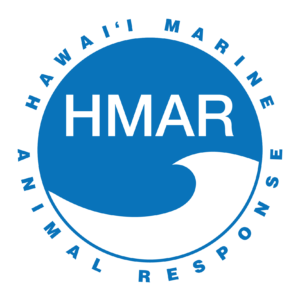MONTHLY HMAR UPDATE: September 2023
September had large marine debris retrievals, two new additions to the team, and hawksbill hatchlings! We’re so excited to tell you all about it!
Number of contacts made to HMAR hotlines in September 2023 – 1,014 contacts
This is broken down by 768 contacts regarding Hawaiian monk seals, 162 contacts regarding sea turtles, and 21 contacts regarding seabirds. The remaining 63 contacts were not regarding marine animals of concern.
Number of field support actions conducted in September 2023 – 302 actions
This was broken out as 14 in the east section of Oʻahu, 49 in the lower west area, 2 in the upper west, 4 in the north area, and 233 in the southeast area of Oʻahu.
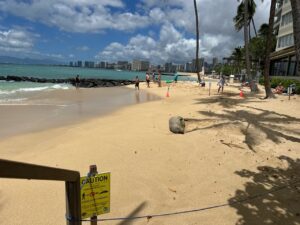
Last month, we had both new and long-time Waikīkī seals frequenting the town-side beaches. RK96, known as “Kaʻiwi,”and RH58, nicknamed “Rocky,” who are more familiar faces on the town side, were joined by RK24, “Wāwāmalu,” and RN14. A new addition to Waikīkī is a young female seal called “Mahina,” also known as RQ44, who was born in 2022 on Mānana Island. Mahina began hauling out in early September and is progressively becoming greener with each passing day. This indicates that she may be preparing for her first major molt, during which she sheds her outer layer of skin and older fur coat (pelage) to be replaced with a new shiny silver one!
We extend our gratitude to all members of the public who have been calling in and assisting us in tracking these seals all around the island. If you ever happen to spot one of the Hawaiian monk seals in town or anywhere else on the island, please report it to the statewide NOAA marine wildlife hotline at (888) 256-9840!
Mahalo!
Number of rescues, interventions, stranding responses, and escalated field actions in September 2023 – 30
This was broken out as 22 operations for sea turtles, 7 operations for seabirds, and 1 for Hawaiian monk seals. We had one rescue operation for a rare hawksbill hatchling and one large downed seabird.
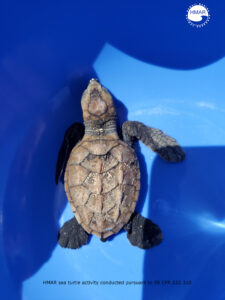 On September 24th, we received a call about a small baby sea turtle, barely the size of the palm of your hand, in Kahuku that appeared to be a bit lost. Upon receiving pictures, to the surprise of our field staff, it turned out to be a baby hawksbill turtle! Encountering hatchling hawksbill sea turtles on Oʻahu, isn’t that uncommon but these animals aren’t coming from known hawksbill nesting sites on Oʻahu. Instead, it is believed they are coming from nesting sites on Molokai, Maui or Hawaiʻi Island. After making their way to the ocean, some of these wayward seafarers get caught in offshore currents and trade winds and some are pushed into the windward shores of Oʻahu. By the time our responder reached the hatchling, it had already grown dark, and releasing it that night could have been dangerous for both the turtle and our staff. Therefore, it was decided to create a moist sand bed for the turtle and keep it overnight. On the morning of September 25th, the hatchling was brought to a sheltered beach and released in an area of offshore winds to give this little one the best chance at survival! This incident serves as a stark reminder that our turtle hatchlings face numerous challenges during their first hours to days of life, including predators, exhaustion, dehydration, or becoming disoriented due to nearby shore lighting. Therefore, please call the statewide NOAA marine wildlife hotline at (888) 256-9840 if you ever come across a sea turtle hatchling on shore – and please do not attempt to intervene. It is best for the animals to let a properly trained and permitted responder handle the situation.
On September 24th, we received a call about a small baby sea turtle, barely the size of the palm of your hand, in Kahuku that appeared to be a bit lost. Upon receiving pictures, to the surprise of our field staff, it turned out to be a baby hawksbill turtle! Encountering hatchling hawksbill sea turtles on Oʻahu, isn’t that uncommon but these animals aren’t coming from known hawksbill nesting sites on Oʻahu. Instead, it is believed they are coming from nesting sites on Molokai, Maui or Hawaiʻi Island. After making their way to the ocean, some of these wayward seafarers get caught in offshore currents and trade winds and some are pushed into the windward shores of Oʻahu. By the time our responder reached the hatchling, it had already grown dark, and releasing it that night could have been dangerous for both the turtle and our staff. Therefore, it was decided to create a moist sand bed for the turtle and keep it overnight. On the morning of September 25th, the hatchling was brought to a sheltered beach and released in an area of offshore winds to give this little one the best chance at survival! This incident serves as a stark reminder that our turtle hatchlings face numerous challenges during their first hours to days of life, including predators, exhaustion, dehydration, or becoming disoriented due to nearby shore lighting. Therefore, please call the statewide NOAA marine wildlife hotline at (888) 256-9840 if you ever come across a sea turtle hatchling on shore – and please do not attempt to intervene. It is best for the animals to let a properly trained and permitted responder handle the situation.

Later in the month, on the 29th, we received a call about an injured seabird outside someone’s house in Hauʻula. Based on the pictures and the assessment by our field staff, it was identified as a brown booby with what appeared to be a broken or dislocated wing. Upon arrival at the scene, the sun had already set, and the bird had perched itself on a ledge near a house. As our staff approached the bird, it responded with loud squawks and attempted to shuffle back towards the water. Our staff member acted quickly, securing the bird and transporting it to our partners at Feathers and Fur Animal Hospital for veterinarian support.. Unlike some of our more passive feathered friends, such as shearwaters, these large seabirds can pose a danger if approached when injured. Therefore, please refrain from approaching a bird like this or attempting to handle it yourself. Always make the call so that the bird can be assessed and rescued by trained responders.
Marine Debris – Large Debris Recovery!
The month began on a strong note with a cleanup event hosted by Nudi Wear at Waiāhole Beach Park to commemorate World Cleanup Day. Our marine debris team collaborated with Aaron’s dive shop and a group of dedicated volunteers, resulting in the removal of over 2,500 pounds of trash! Among the items collected were 14 tires, a boat engine, and even an entire kayak. If you’re interested in participating in HMAR’s weekend cleanups, consider applying to become a marine debris volunteer or follow us on Instagram, where we regularly post updates about upcoming cleanups that HMAR will be involved in.
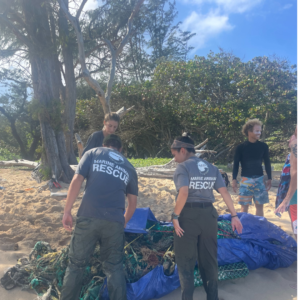 We conducted four marine debris in-water dives this month collecting 1,400 feet of monofilament line and 369 animal hazards. On top of our dives, as the State of Hawaiʻi Division of Aquatic Resources Marine Debris Rapid Response contractor on Oʻahu, HMAR was called out to a large net mass in Malaekahana State Park, adjacent to the campgrounds. The call came in around midday from nearby campers who had been attempting to move the net mass on the beach above the tide line but was having no luck. Once our team arrived on-site, we initiated the process of cutting apart the net for removal. However, the incoming tide posed a challenge, and the separation of the net pieces was taking too long. After utilizing various resources from our response truck we rigged a sling, allowing members of the public to assist. It took approximately 13 people to move the estimated 800-pound net mass away from the waterline and into the bed of our truck. Mahalo to everyone who contributed to this effort and to the individual who alerted us to this significant animal hazard. If you ever come across derelict fishing gear or nets in or out of our waters, please don’t hesitate to contact our Hawaiʻi DLNR Marine Debris Rapid Response hotline at 833-4-DA-NETS.
We conducted four marine debris in-water dives this month collecting 1,400 feet of monofilament line and 369 animal hazards. On top of our dives, as the State of Hawaiʻi Division of Aquatic Resources Marine Debris Rapid Response contractor on Oʻahu, HMAR was called out to a large net mass in Malaekahana State Park, adjacent to the campgrounds. The call came in around midday from nearby campers who had been attempting to move the net mass on the beach above the tide line but was having no luck. Once our team arrived on-site, we initiated the process of cutting apart the net for removal. However, the incoming tide posed a challenge, and the separation of the net pieces was taking too long. After utilizing various resources from our response truck we rigged a sling, allowing members of the public to assist. It took approximately 13 people to move the estimated 800-pound net mass away from the waterline and into the bed of our truck. Mahalo to everyone who contributed to this effort and to the individual who alerted us to this significant animal hazard. If you ever come across derelict fishing gear or nets in or out of our waters, please don’t hesitate to contact our Hawaiʻi DLNR Marine Debris Rapid Response hotline at 833-4-DA-NETS.
Number of people reached through face-to-face outreach and education in September 2023 – 1,645 people
This month, members of our team involved in our Education & Engagement Program continued their outreach and tabling at Waikīkī Aquarium on Mondays from 11am-2pm. HMAR also participated in the University of Hawaiʻi at Mānoa volunteer event where we were able to talk to students about volunteering and interning in our programs.
Additional news & updates
 HMAR is delighted to introduce two new staff members who will be taking on the roles of Field Operations Technicians. The first member is Marcela Curcio, and the second is Alex Bauer. Marcela is a former intern who graduated from Boston College with a Bachelor’s degree in Biology and has previous experience working at various marine life centers. Alex, also a former HMAR intern, is on the verge of completing his Bachelor of Science degree in Marine Biology from the University of Hawaiʻi at Mānoa. Welcome to the team, Marcela and Alex!
HMAR is delighted to introduce two new staff members who will be taking on the roles of Field Operations Technicians. The first member is Marcela Curcio, and the second is Alex Bauer. Marcela is a former intern who graduated from Boston College with a Bachelor’s degree in Biology and has previous experience working at various marine life centers. Alex, also a former HMAR intern, is on the verge of completing his Bachelor of Science degree in Marine Biology from the University of Hawaiʻi at Mānoa. Welcome to the team, Marcela and Alex!
Our new volunteer orientation is now open for applications for our November 4th class! If you’re interested in joining the HMAR team, please visit our website and click on “Get Involved” or follow this link HERE. We offer a variety of programs that are always in need of participants. You can apply to become one of our Field Support & Outreach (FSO) volunteers who work on the beaches with monk seals, or become a marine debris volunteer participating in snorkel clean-up dives every weekend, or work as an educator in our Education & Engagement Program, or as a hotline operator from the comfort of your home in our Operations Support Program (OSP). Learn more by going HERE.
Mahalo for your support!
______________________________________________________________________________
WHAT DO THESE NUMBERS MEAN?
Number of Calls – What does this mean? These are contacts that our hotline operators answer about any species in any situation. Whether it is a monk seal on the beach, a sea turtle of concern in the water, or a seabird that needs help. HMAR answers the calls that are made to the NOAA’s marine wildlife number for Oʻahu and Molokaʻi and we take calls from the public, from the police, fire department, Ocean Safety as well as State of Hawaiʻi agencies. Some calls result in a field response but many are valuable for animal sightings information or other data that can assist in research. Since our start in 2016, we’ve handled over 63,000 hotline contacts.
Number of Field Support Actions – What does this mean? This is when HMAR sends volunteer or staff resources into the field to perform a variety of actions in support of marine protected animals including Hawaiian monk seals, sea turtles, sea birds, dolphins, whales or marine debris. Since our start in 2016, we have had volunteers or staff in the field over 27,300 times.
Number of Rescues, Interventions, Stranding Responses and Escalated Field Actions – What does this mean? This number includes any field response that goes above and beyond a typical resting monk seal response. This includes responding to a seal of concern, an entangled, hooked, or injured sea turtle, a seabird in need of medical support, and other situations. Since 2016, we have performed nearly 2,300 of these operations.
Marine Debris Work – Each week our marine debris team removes underwater entanglement hazards (net, line, hooks) from high fishing pressure areas to reduce animal entanglements, hookings, injuries and death of protected marine animals. Since we started our underwater removal activities, our Marine Debris Program (MDP) and our BEAT DEBRIS citizen science project has removed about 6,000 animal hazards, cleaned over 281 acres of underwater habitat, and we have collected over 23 miles of monofilament fishing line. Taking all of this debris out of underwater habitat helps save Hawaiian monk seals, sea turtles, and seabirds.
Number of People Reached through Face to Face Outreach – What does this mean? HMAR’s different program activities put our volunteers and staff in direct contact with Hawai’iʻs residents and visitors. Educating people about Hawai’i’s marine protected species and our ocean ecosystem is one of our highest priorities and has an important impact on reducing threats. This number includes outreach done in the field as well as the work our Education and Engagement team accomplishes through community outreach events and other educational activity. Since our start we’ve reached 316,650 people.
